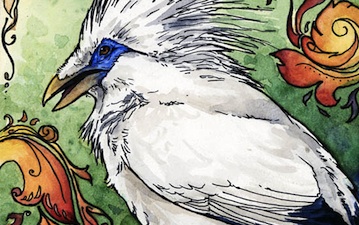The Bali Myna (Leucopsar rothschildi), also known as Rothschild’s Mynah, Bali Starling, or Bali Mynah, locally known as Jalak Bali, is a medium-sized (up to 25 cm long), stocky myna, almost wholly white with a long, drooping crest, and black tips on the wings and tail. The bird has blue bare skin around the eyes, greyish legs and a yellowbill. Both sexes are similar.
The Bali Myna is restricted to the island of Bali in Indonesia, where it is the island’s only endemic vertebrate species. (An endemic subspecies, the Bali Tiger, has been extinct since 1937.) The bird was discovered in 1910, and in 1991 was designated the fauna symbol of Bali. Featured on the Indonesian 200 rupiah coin, its local name is “Jalak Bali”.
In its natural habitat however it is far less conspicuous, using tree tops for cover and–unlike other starlings–usually coming to the ground only to drink; this would seem to be an adaptation to the fact that it is instantly noticeable topredators when out in the open. The Bali mynah often gathers in groups to better locate food and watch out for predators.[2]
The Bali Myna’s diet includes fruit, seeds, worms and insects.[2]
The Bali Myna, Bali’s regional mascot, is critically endangered, hovering immediately above extinction in the wild for several years now (BirdLife International 2006). The Bali Myna is listed in Appendix I of CITES. Trade even in captive-bred specimens is strictly regulated and the species is not generally available legally to private individuals. However, experienced aviculturalists may become affiliated with the captive-breeding program, allowing them to legally keep this species. The exact number of birds remaining in the wild is unknown, with estimates in 2012 of 24 adults in West Bali National Park and over 100 on the Balinese island of Nusa Penida. At least 1,000 birds are believed to be held in captivity legally. The number of captive birds bought onblack market is estimated to be twice the number of legally-acquired individuals in the captive breeding program.
There are 2 remaining locations on Bali where the birds exist in the wild: the West Bali National Park; and Bali’s small island ofNusa Penida
(From Wikipedia, October 28, 2012)




